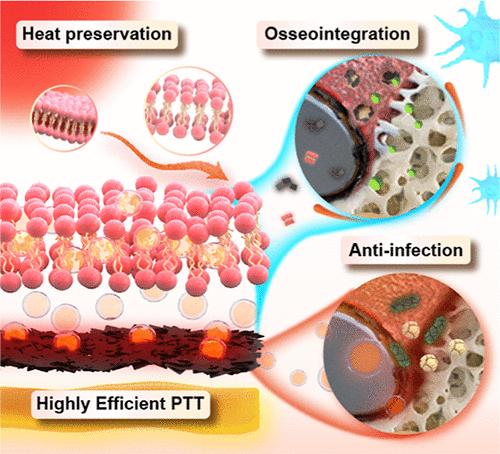Engineering Coatings Inspired by Cell Membrane Thermal Dynamics to Enhance Photothermal Therapy and Osteogenesis for Implant Infections
IF 8.2
2区 材料科学
Q1 MATERIALS SCIENCE, MULTIDISCIPLINARY
引用次数: 0
Abstract
Photothermal therapy (PTT) encounters challenges of rapid thermal loss and potential tissue damage. In response, we propose a Heat-Boost and Lock implant coating strategy inspired by the thermal adaptation of biological membranes, enabling precise local photothermal utilization. This coating incorporates a poly(tannic acid) (pTA) bridging layer on implants, facilitating stable layer-by-layer integration of a black phosphorus (BP) photothermal layer and a top cell membrane Heat-Boost and Lock layer. The cell membrane layer significantly curtails photothermal loss (extending the heat retention by 17.62%) and stores energy within its phospholipid bilayer, boosting photothermal effects near implants (achieving a temperature increasement of 275%). Theoretical analysis indicates that these local heat preservation properties of the cell membrane arise from its low thermal conductivity and phase-change properties. In a Staphylococcus aureus-infected bone implant model, our coating demonstrates precise antibacterial action around implants (reach an antibacterial ratio of 99.52%). The synergetic locking function of cell membrane and pTA delays BP biodegradation, ensuring favorable photothermal stability and long-term osteo-inductive performance (increasing the bone volume fraction by 53.45%). Beyond providing an endogenic biointerface, this strategy extends the application of cell membrane in local thermal management, offering possibilities for effective and safe PTT modalities.

受细胞膜热动力学启发的工程涂层可增强植入物感染的光热疗法和成骨作用
光热疗法(PTT)面临着热量快速流失和潜在组织损伤的挑战。为此,我们从生物膜的热适应性中汲取灵感,提出了一种 "热促进和锁定 "植入体涂层策略,从而实现了局部光热的精确利用。这种涂层在植入物上加入了聚(单宁酸)(pTA)桥接层,促进了黑磷(BP)光热层和顶层细胞膜热增强和锁定层的逐层稳定整合。细胞膜层大大减少了光热损失(将热保留时间延长了 17.62%),并在其磷脂双分子层中储存了能量,从而增强了植入体附近的光热效应(使温度提高了 275%)。理论分析表明,细胞膜的这些局部保温特性源于它的低导热性和相变特性。在金黄色葡萄球菌感染的骨植入模型中,我们的涂层在植入物周围显示出精确的抗菌作用(抗菌率达到 99.52%)。细胞膜和 pTA 的协同锁定功能延缓了 BP 的生物降解,确保了良好的光热稳定性和长期骨诱导性能(骨体积分数增加了 53.45%)。除了提供内源性生物界面,这种策略还扩展了细胞膜在局部热管理中的应用,为有效、安全的 PTT 模式提供了可能性。
本文章由计算机程序翻译,如有差异,请以英文原文为准。
求助全文
约1分钟内获得全文
求助全文
来源期刊

ACS Applied Materials & Interfaces
工程技术-材料科学:综合
CiteScore
16.00
自引率
6.30%
发文量
4978
审稿时长
1.8 months
期刊介绍:
ACS Applied Materials & Interfaces is a leading interdisciplinary journal that brings together chemists, engineers, physicists, and biologists to explore the development and utilization of newly-discovered materials and interfacial processes for specific applications. Our journal has experienced remarkable growth since its establishment in 2009, both in terms of the number of articles published and the impact of the research showcased. We are proud to foster a truly global community, with the majority of published articles originating from outside the United States, reflecting the rapid growth of applied research worldwide.
 求助内容:
求助内容: 应助结果提醒方式:
应助结果提醒方式:


